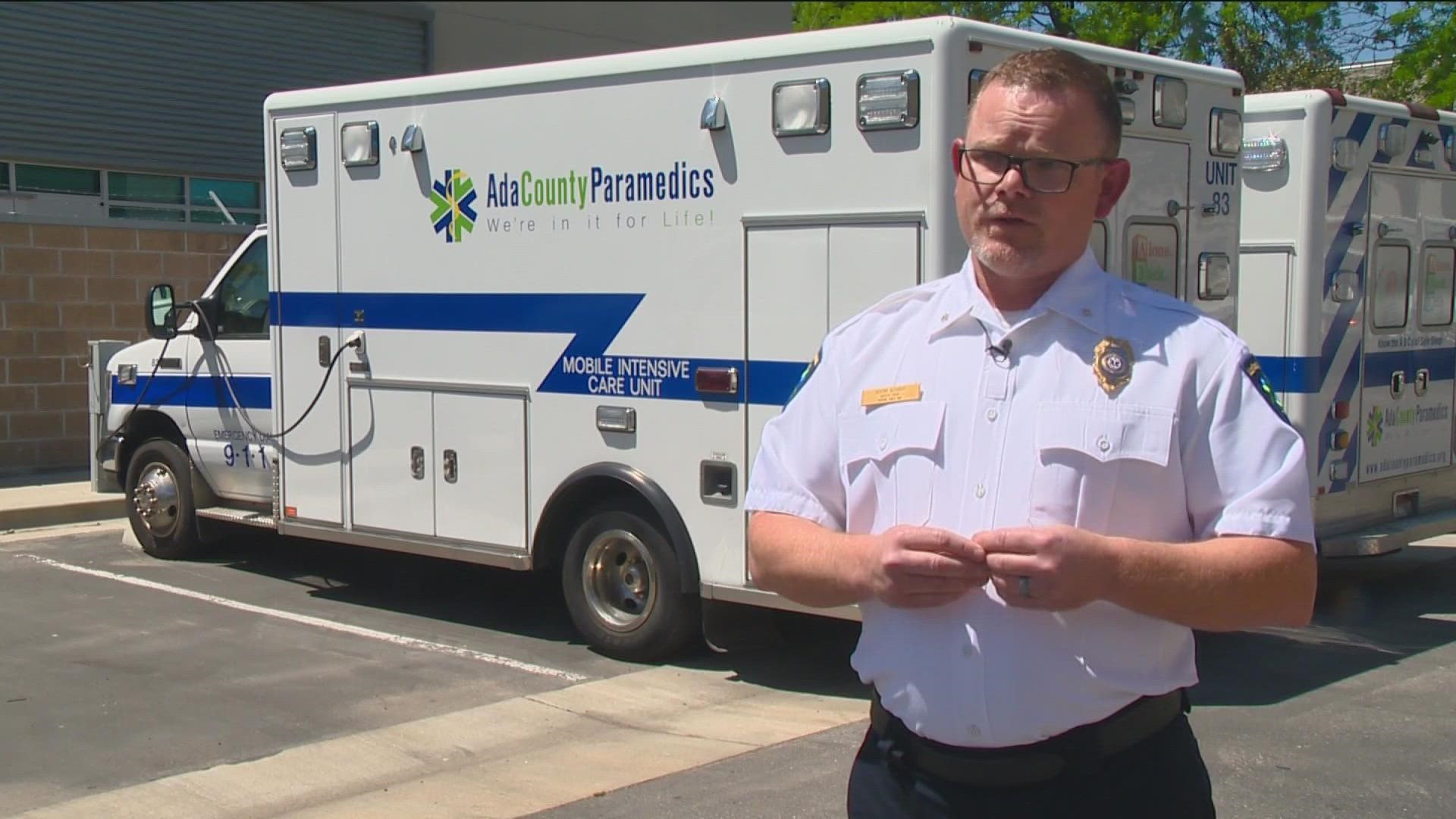BOISE, Idaho — The need for more paramedics and EMTs will increase significantly by 2030, according to a report by the American Ambulance Association. Some agencies around Idaho have felt the pinch in staffing, especially rural departments that rely on volunteer EMTs.
Several agencies say the situation has gotten better since the height of the pandemic, when they saw many staff members leaving the industry. However, the state's largest county still needs to fill more positions.
In an emergency, paramedics and EMTs are one of the first to respond.
"Every time the bell sounds and you're called out you get a chance to make a difference," the deputy chief of training and safety for Ada County Paramedics, Jeremy Schabot said.
Making a difference is why many people joined the industry, but throughout the pandemic that hasn't always been enough to keep many in it.
"It has a toll," Schabot said. "The increased workload has led people to consider whether or not this is what they want to do for the long term."
Data from Ada County Paramedics shows the number of calls in 2021 increased by 11% from 2020. Schabot attributed it to the amount of people who have moved into Ada County throughout the pandemic.
Even with growth, Schabot said they have been able to manage and provide adequate services in the county, but he said there's room for improvement.
"We always like to be quicker and faster to the calls for service, but that all won't always be the case. Unless we're able to expand and add resources to the system," Schabot said.
Ada County Paramedics need to fill eight positions, which is a tough task when there is competition all around the area and potential paramedics and EMS have other options.
"We compete on a normal basis with our public safety partners," Schabot said. "Our fire departments also employ paramedics and EMTs and advanced EMTs. The hospitals, because of the shortage they've had for staffing, have also looked to dip into the paramedic advanced EMT and EMT pool for staffing."
Ada County Paramedics are hoping to be more competitive with pay next year. They are proposing pay increases for paramedics, Advanced EMTs and EMTs wages for the 2023 fiscal year budget, which will need to be approved by the Ada County Board of County Commissioners.
Current:
- Paramedic – $54,566 48-hr week
- AEMT – $39,505 48-hr week
- EMT – $37,288 48-hr week
Beginning Oct. 1, 2022 (proposed):
- Paramedic – $54,784 48-hr week ($21.00/hr)
- AEMT – $42,777 48-hr week ($15.82/hr)
- EMT- $40,560 48-hr week ($15.00/hr)
Beginning Jan. 1, 2023 (proposed):
- Paramedic – $69,888 56-hr week ($21.00/hr)
- AEMT – $52,648 56-hr week ($15.82/hr)
- EMT- $49,920 56-hr week ($15.00/hr)
Personnel will make 16 hours of overtime, something Schabot said is very similar to how local firefighters' schedules work.
While Ada County may be dealing with a slight shortage, not all EMS agencies in the state have trouble staffing.
"We are getting a lot of applicants from out of state as people are moving into the state. We're seeing that as kind of a benefit," the director of EMS for St. Luke's Health's Magic Valley Paramedics, Blaine Patterson said.
Patterson said they struggled with short staffing throughout the pandemic, but the agency bounced back, even with a high number of calls they have responded to. He said Magic Valley Paramedics are on track to respond to 13,000 calls this year.
"We can focus on recovery and regeneration a little bit more now and we can plan better for future events not related to the pandemic," Patterson said.
Now, the negative impacts they are seeing come from the partnerships between rural fire departments and EMS agencies that rely on EMT volunteers.
A report from the Idaho Office of Performance Evaluations on volunteer providers of Emergency Medical Services shows Idaho has nearly 2,000 EMS volunteers, which make up 40% of EMS providers statewide. The report also shows 69% of rural Idaho relies on volunteers.
"The number of EMS providers has not kept up with population growth. Stakeholders reported that recruiting and retaining sufficient staff is one of the biggest challenges for EMS in Idaho," the report stated.
"It's not somebody's primary job and that's who's really feeling the pinch," Patterson said. He added many volunteers in rural areas are growing older and retiring.
Patterson added the pandemic's impacts and burden on the industry continue to linger in those areas.
"There are other parts of the state where, if you call 911, it might be a while before you get an ambulance," Patterson said.
More funding is on its way for EMS agencies in the Gem State. Senate Bill 1283 was signed by Governor Brad Little back in March. The bill will allow EMS agencies to receive more money from Medicaid for responding to calls in addition to the payment they already get.
Currently, Medicaid only reimburses about a quarter of the cost of ground emergency medical transport (GMT). This will be a supplemental reimbursement for GMT and would not be a cost to the state or local governments.
"It will help but it's not the total solution," Schabot said. "But it is a start."
Another piece of legislature was also signed into law this past session, House Bill 561, aiming to provide more funds for EMS in Idaho. It will expand the potential use of grant funds for EMS to allow for not only the purchase of vehicles and equipment but also to include training, licensing, technology and costs not related to the salary of personnel.
Watch more Local News:
See the latest news from around the Treasure Valley and the Gem State in our YouTube playlist:

